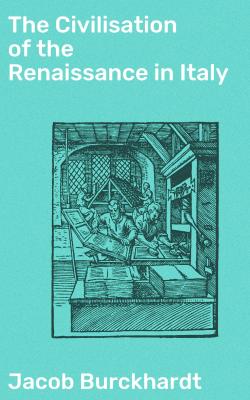Скачать книгу
Scenic splendour, the enemy of the drama
316
|
|
The intermezzo and the ballet
|
317
|
|
Comedies and masques
|
320
|
|
Compensation afforded by music
|
321
|
|
Epic romances
|
321
|
|
Necessary subordination of the descriptions of character
|
323
|
|
Pulci and Bojardo
|
323
|
|
Inner law of their compositions
|
324
|
|
Ariosto and his style
|
325
|
|
Folengo and parody
|
326
|
|
Contrast offered by Tasso
|
327
|
|
CHAPTER V. BIOGRAPHY.
|
|
Advance of Italy on the Middle Ages
|
328
|
|
Tuscan biographers
|
330
|
|
Biography in other parts of Italy
|
332
|
|
Autobiography; Æneas Sylvius
|
333
|
|
Benvenuto Cellini
|
333
|
|
Girolamo Cardano
|
334
|
|
Luigi Cornaro
|
335
|
|
CHAPTER VI. THE DESCRIPTION OF NATIONS AND CITIES.
|
|
The ‘Dittamondo’
|
339
|
|
Descriptions in the sixteenth century
|
339
|
|
CHAPTER VII. DESCRIPTION OF THE OUTWARD MAN.
|
|
Boccaccio on Beauty
|
344
|
|
Ideal of Firenzuola
|
345
|
|
His general definitions
|
345
|
|
CHAPTER VIII. DESCRIPTIONS OF LIFE IN MOVEMENT.
|
|
Æneas Sylvius and others
|
349
|
|
Conventional bucolic poetry from the time of Petrarch
|
350
|
|
Genuine poetic treatment of country life
|
351
|
|
Battista Mantovano, Lorenzo Magnifico, Pulci
|
352
|
|
Angelo Poliziano
|
353
|
|
Man, and the conception of humanity
|
354
|
|
Pico della Mirandola on the dignity of man
|
354
|
|
PART V. SOCIETY AND FESTIVALS.
|
|
CHAPTER I. THE EQUALISATION OF CLASSES.
|
|
Contrast to the Middle Ages
|
359
|
|
Common life of nobles and burghers in the cities
|
359
|
|
Theoretical criticism of noble birth
|
360
|
|
The nobles in different parts of Italy
|
362
|
|
The nobility and culture
|
363
|
|
Bad influence of Spain
|
363
|
|
Knighthood since the Middle Ages
|
364
|
|
The tournaments and the caricature of them
|
365
|
|
Noble birth as a requisite of the courtier
|
367
|
|
CHAPTER II. OUTWARD REFINEMENT OF LIFE.
|
|
Costume and fashions
|
369
|
|
The toilette of women
|
371
|
|
Cleanliness
|
374
|
|
The ‘Galateo’ and good manners
|
375
|
|
Comfort and elegance
|
376
|
|
CHAPTER III. LANGUAGE AS THE BASIS OF SOCIAL INTERCOURSE.
|
|
Development of an ideal language
|
378
|
|
Its wide diffusion
|
379
|
|
The Purists
|
379
|
|
Their want of success
|
382
|
|
Conversation
|
Скачать книгу
|

